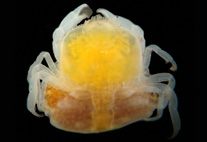Abstract
Four new species of the genus Litinium are described from mangroves and from deep sea. The genus Litinium now includes ten valid species. An emended generic diagnosis and a pictorial guide for species identification are given. Litinium quangi sp. n. and L. curticauda sp. n., both found in mangroves of South Vietnam, are morphologically similar and differ from other congeneric species in body size, having short anterior setae, ovoid amphideal fovea and a short rounded tail. Litinium quangi differs from L. curticauda in the number of midventral preanal supplementary setae (one in L. quangi and two in L. curticauda) and relative tail length (c' 1.12–1.63 in L. quangi and 0.83–0.94 in L. curticauda). Litinium abyssorum sp. n. and L. profundorum sp. n., both collected from the Angola Basin, South-East Atlantic Ocean, at depth 5400 m, are also morphologically similar and differ from other species of the genus by having a smaller body and relatively large amphideal fovea with deep invagination of the anterior edge. Litinium abyssorum differs from L. profundorum in the number of midventral preanal setae (two in L. abyssorum, one in L. profundorum), relative tail length (c' 3.61 in L. abyssorum and 1.17 in L. profundorum) and L. abyssorum has unequal spicules.

